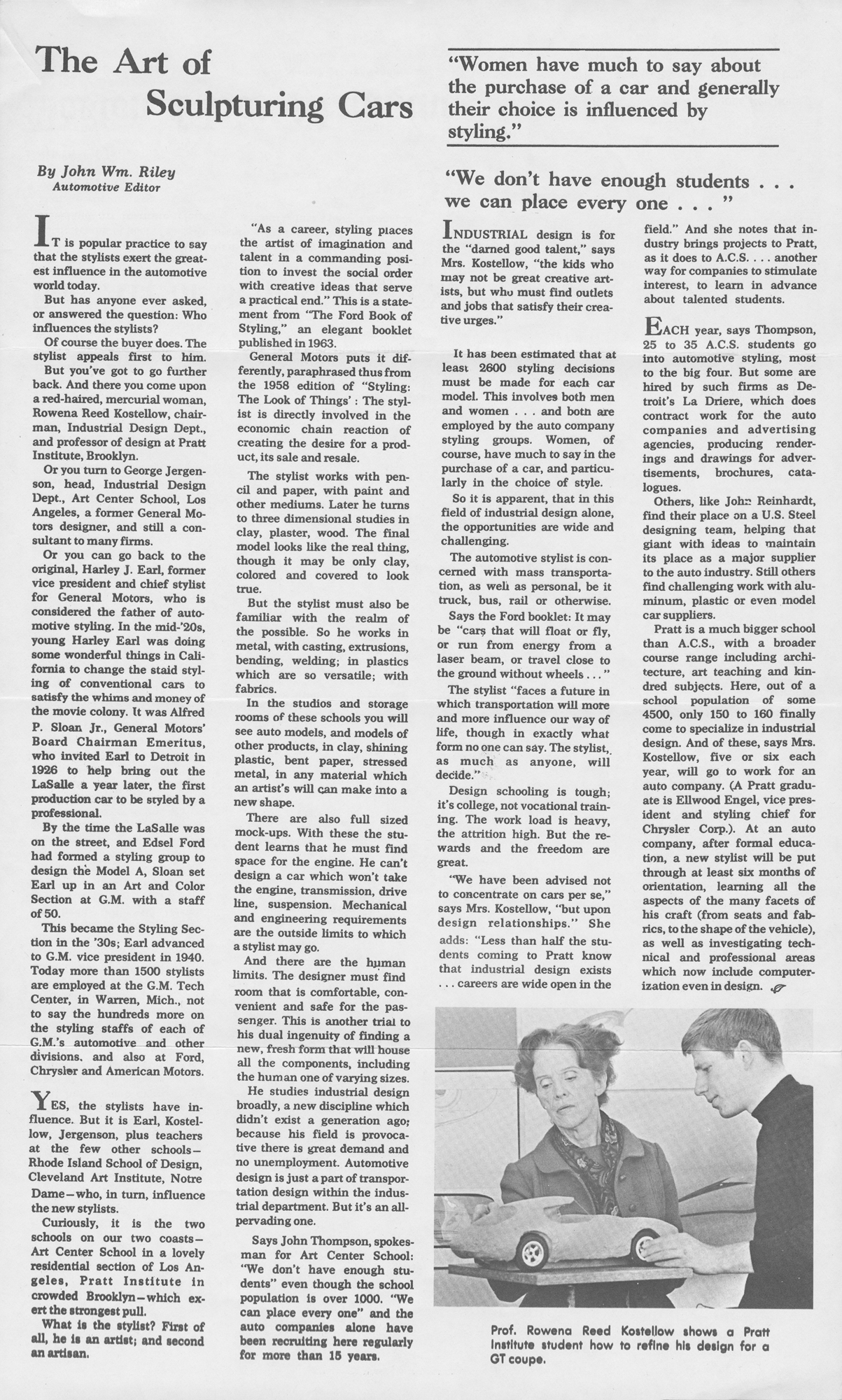The Art of Sculpting Cars

Boston Globe Magazine, March 6, 1966
The Art of Sculpturing Cars
By John Wm. Riley
Automotive Editor
It is popular practice to say that the stylists exert the greatest influence in the automotive world today.
But has anyone ever asked, or answered the question: Who influences the stylists?
Of course the buyer does. The stylist appeals first to him.
But you’ve got to go further back. And there you come upon a red-haired, mercurial woman, Rowena Reed Kostellow, chair-man, Industrial Design Dept., and professor of design at Pratt Institute, Brooklyn.
Or you turn to George Jergen-son, head, Industrial Design Dept., Art Center School, Los Angeles, a former General Motors designer, and still a consultant to many firms.
Or you can go back to the original, Harley J. Earl, former vice president and chief stylist for General Motors, considered the father of automotive styling. In the mid-’20s, young Harley Earl was doing some wonderful things in California to change the staid styling of conventional cars to satisfy the whims and money of the movie colony. It was Alfred P. Sloan Jr., General Motors’ Board Chairman Emeritus, who invited Earl to Detroit in 1926 to help bring out the LaSalle a year later, the first production car to be styled by a professional.
By the time the LaSalle was on the street, and Edsel Ford had formed a styling group to design the Model A, Sloan set Earl up in an Art and Color Section at G.M. with a staff of 50.
This became the Styling Section in the 30s; Earl advanced to G.M. vice president in 1940. Today more than 1500 stylists are employed at the G.M. Tech Center, in Warren, Mich., not to say the hundreds more on the styling staffs of each of G.M.’s automotive and other divisions, and also at Ford, Chrysier and American Motors.
YES, the stylists have in-fluence. But it is Earl, Kostel-low, Jergenson, plus teachers at the few other schools – Rhode Island School of Design, Cleveland Art Institute, Notre Dame- who, in turn, influence the new stylists.
Curiously, it is the two schools on our two coasts- Art Center School in a lovely residential section of Los Angeles, Pratt Institute in crowded Brooklyn-which exert the strongest pull.
What is the stylist? First of all, he is an artist; and second an artisan.
“As a career, styling places the artist of imagination and talent in a commanding position to invest the social order with creative ideas that serve a practical end.” This is a statement from “The Ford Book of Styling,” an elegant booklet published in 1963.
General Motors puts it differently, paraphrased thus from the 1958 edition of “Styling: The Look of Things’: The stylist is directly involved in the creating the desire for a product, its sale and resale.
The stylist works with pencil and paper, with paint and other mediums. Later he turns to three dimensional studies in clay, plaster, wood. The final model looks like the real thing, though it may be only clay, colored and covered to look true.
But the stylist must also be familiar with the realm of the possible. So he works in metal, with casting, extrusions, bending, welding; in plastics
In the studios and storage rooms of these schools you will see auto models, and models of other products, in clay, shining metal, in any material which an artist’s will can make into mock-ups. With these the student learns that he must find space for the engine. He can’t design a car which won’t take the engine, transmission, drive and engineering requirements are the outside limits to which a stylist may go.
The designer must find room that is comfortable, convenient and safe for the pas-senger. This is another trial to his dual ingenuity of finding a new, fresh form that will house all the components, including the human one of varying sizes.
He studies industrial design broadly, a new discipline which didn’t exist a generation ago; because his field is provocative there is great demand and no unemployment. Automotive design is just a part of transportation design within the industrial department. But it’s an all-
Says John Thompson, spokesman for Art Center “We don’t have enough students” even though the school population is over 1000. “We can place every one” and the auto companies alone been recruiting here regularly for more than 16 years.
“Women have much to say about the purchase of a car and generally their choice is influenced by styling.”
“We don’t have enough students • • • we can place every one … “
INDUSTRIAL design is for field.” And she notes that in-the “darned good talent,” says Mrs. Kostellow, “the kids who may not be great creative artists, but who must find outlets and jobs that satisfy their creative urges.